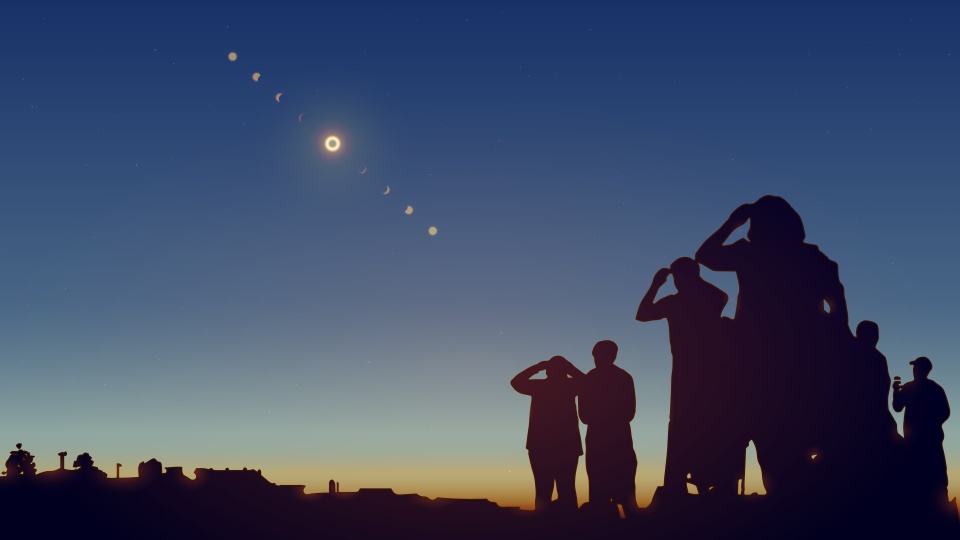Georgia Tech's Sonification Lab Revolutionizes Eclipse Experience for Visually Impaired

As the April 8 solar eclipse approaches, millions of people anticipate participating in the wonder of this celestial event. Yet, for those with visual impairments, traditional methods of observing such phenomena may present limitations. Fortunately, resources from the team of Tech’s School of Psychology professor, Bruce Walker, offer an inclusive approach, ensuring that everyone can engage with and appreciate the eclipse experience. Through detailed auditory descriptions and immersive virtual environments, the Sonification Lab facilitates accessibility to the wonders of the universe for all, regardless of visual ability.
“This is the absolute first technology of its kind to give blind and visually impaired users the complete information and spatial knowledge of a map, especially for an eclipse,” said Brandon Biggs, Ph.D. student in the Human Centered Computing (HCC) program in the School of Interactive Computing.
At the forefront of the Sonification Lab’s research efforts are the resources provided by the lab’s website. This comprehensive platform serves as a hub for eclipse enthusiasts, offering detailed maps, predictions, and scientific insights into the upcoming solar eclipse. These resources are integral to the Sonification Lab's work, enabling them to create fully accessible and accurate auditory representations of the eclipse experience, says Walker.
Crafting an Immersive Soundtrack
Through meticulous analysis and interpretation of the data, Walker's team crafts auditory representations of the eclipse that accurately depict its various phases and phenomena. Each element, from the gradual obscuration of the sun to the fleeting moments of totality, he adds, is translated into carefully composed melodies and rhythms. This soundtrack offers listeners a unique and immersive way to experience the celestial event.
“It’s almost like infotainment,” said Walker. “We want to give a complete experience of totality during the eclipse, with the immersive sound of what birds and other animal behaviors would be at that time.”
As the moon begins to move across the face of the sun, the soundtrack reflects this gradual obscuration through subtle shifts in melody and rhythm. The gradual dimming of light is mirrored by a gradual crescendo in the music, creating a sense of anticipation and tension.
During the brief moments of totality, when the moon completely blocks the sun, the soundtrack reaches a climax. This crescendo symbolizes the awe-inspiring beauty of totality, capturing the profound experience of witnessing the sun's corona against the backdrop of darkness.
"Pull" Style Audio Map: This map outlines the precise path the solar eclipse will take across North America. It provides information about the regions that will experience totality, using the same path data from NASA. The map’s features offer both low lighting and an interactive icon to follow the route of the eclipse, making it engaging and web-accessibility compliant. By incorporating data from this map, the Sonification Lab ensures that their auditory representations align with the geographical features of the eclipse path.
"Push" Style Map: This map provides detailed information about the timing of the eclipse in various locations. According to Walker, the map highlights the moments of partial and total eclipse, allowing listeners to follow the progression of the event in real time. By integrating data from this map, the Sonification Lab synchronizes their auditory compositions with the chronological sequence of the eclipse.
Enhancing Accessibility Through VR Technology
In addition to facilitating this auditory experience, the Sonification Lab also explores virtual reality (VR) capabilities to enhance accessibility for those unable to witness the eclipse firsthand. By immersing users in a virtual environment, complete with visual and auditory components, VR technology enables individuals to experience the eclipse in a highly immersive and interactive manner.
Walker explains that, in the VR environment, users can explore detailed visual representations of the eclipse, including accurate depictions of the sun, moon, and Earth. These visual components provide additional context and enrichment to the auditory experience, allowing users to better understand the celestial mechanics at play.
To delve deeper into the wonders of the cosmos and experience the eclipse in a whole new way, individuals are encouraged to visit the website here.